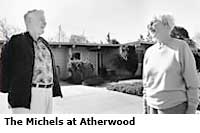Eichler's Early Years: 1949-'50 The First Subdivisions
Pushing aside a brand-new "cement box with little windows," Muriel and Bill Mickel bought into the Eichler dream at the very beginning. Steven and Jean Aronson, fleeing the gloom of big city fog, stumbled onto their Eichler 50 years ago and have been hooked ever since.
"We bought ours sight unseen," confessed Muriel Mickel. "We had never seen anything like it before." "We put $150 down, and they asked if we wanted a 100-percent loan," added Jean Aronson, still sounding surprised. "We said sure."
 Those are recollections of 1950, more than 70 years ago. The Mickels and Aronsons were there at the starting gate, and are still living behind Eichler glass today.
Those are recollections of 1950, more than 70 years ago. The Mickels and Aronsons were there at the starting gate, and are still living behind Eichler glass today.
1950 was long before the coming of the expansive Greenmeadows, Willow Glens, and Terra Lindas—a time, in fact, when Joe Eichler's developments were so small, they nearly became buried treasures overnight. But the Mickels and Aronsons still reminisce about those early days. They haven't forgotten Atherwood and Stanford City and Green Gables—and the Gardens of Sunnymount, El Centro, and University.
Back then, Eichlers were strange to everyone, and exciting to only a few. They were modern adventures awaiting an unconventional breed of settler, like the Mickels and Aronsons. And with each emerging subdivision came another opportunity to embellish the prototype of the ever-evolving Eichler model. But in the very beginning, in April 1949, two years into Joe Eichler's second career as the fledgling Sunnyvale Building Company, there was a pioneering development called Sunnyvale Manor I. It incorporated three dozen of the estimated 300 houses Eichler would erect before teaming with Anshen & Allen, his first major architects. More importantly, the Manor represented a big step forward for the budding developer, who used this project to revise his routine of selling prefabricated housing packages erected on the lots of his prospective buyers.
Prompted by one of his company's building superintendents, Eichler bought a 45-acre ranch in Sunnyvale and, for the first time, began to assemble and market the prefabricated houses on his own land. For $500 down, one could buy, as the Palo Alto Times advertised, "the most sensational three-bedroom homes in the entire peninsula area... Quality homes in the modern manner." Opened on N. Bayview Avenue near Maude, Sunnyvale Manor I featured modern orientation, flat and mono-pitched roofs, and central heating (radiant had not yet arrived). By adding a new wrinkle to his business plan, Eichler was off in a new direction.
The builder's second development and his first marketed under the Eichler Homes name, Sunnymount Gardens opened the following month. Also in Sunnyvale, set back from the Saratoga-Sunnyvale Road thoroughfare near Remington Drive, Sunnymount Gardens was an attractive package of 36 homes that seemed to extend the basic design of the Manor. Its horseshoe cul-de-sac site plan (comprised of Dawn Drive and Sunnymount Avenue) was an enticing feature, ensuring quiet, relaxed surroundings.
"Heavenly homes... Out of this world!" read Eichler's May 1949 ad in the Times. "Never before have Californians been offered such truly up-to-the-minute modern homes." The ad copy went on, accentuating "values" and "extras": 1,230 square feet with three bedrooms, a two-car garage, one-and-one-half baths, a brick fireplace, parquet oak floors, and central heating. All for $600 down. Eichler's greatest departure in 1949 from the Manor I model came with two subsequent sister developments, University Gardens and Stanford Gardens—his first step up into the more desirable locales of the peninsula, Palo Alto and Menlo Park. Perhaps spurred by competitors who offered similar designs—the local Bell Construction had promoted their use of architects with modern plans as early as July—this time Eichler decided to recruit a designer (remembered only as "Castor") to upgrade and upscale his design. The results seemed consistently good.
Promoted in the Times as "a new, efficiently planned, quality community of streamlined modern homes," University Gardens' 50-plus homes (on Palo Alto's Josina, Kendall, and Barron Avenues) featured complex roof planes that interlocked and extended over one another. And, as one architectural advisor noted, they offered "a cozier ranch house quality not present in their predecessors." On the down side, Eichler's new plans also brought new prices, presumably taking him into double figures for the first time. University Gardens opened in September for $10,950.
Castor's other contribution, Stanford Gardens, which introduced radiant heat to the Eichler design, was a boldly imaginative development of only a dozen homes lining Menlo Park's secluded Evergreen Street. The homes were impressive—all had two-and-a-half baths—but, at $19,500, likely scared away many prospective buyers, the Aronsons included.




